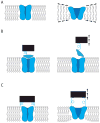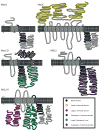MscS-like mechanosensitive channels in plants and microbes
- PMID: 23947546
- PMCID: PMC3791886
- DOI: 10.1021/bi400804z
MscS-like mechanosensitive channels in plants and microbes
Abstract
The challenge of osmotic stress is something all living organisms must face as a result of environmental dynamics. Over the past three decades, innovative research and cooperation across disciplines have irrefutably established that cells utilize mechanically gated ion channels to release osmolytes and prevent cell lysis during hypoosmotic stress. Early electrophysiological analysis of the inner membrane of Escherichia coli identified the presence of three distinct mechanosensitive activities. The subsequent discoveries of the genes responsible for two of these activities, the mechanosensitive channels of large (MscL) and small (MscS) conductance, led to the identification of two diverse families of mechanosensitive channels. The latter of these two families, the MscS family, consists of members from bacteria, archaea, fungi, and plants. Genetic and electrophysiological analysis of these family members has provided insight into how organisms use mechanosensitive channels for osmotic regulation in response to changing environmental and developmental circumstances. Furthermore, determining the crystal structure of E. coli MscS and several homologues in several conformational states has contributed to our understanding of the gating mechanisms of these channels. Here we summarize our current knowledge of MscS homologues from all three domains of life and address their structure, proposed physiological functions, electrophysiological behaviors, and topological diversity.
Figures




Similar articles
-
Gating the bacterial mechanosensitive channels: MscS a new paradigm?Curr Opin Microbiol. 2004 Apr;7(2):163-7. doi: 10.1016/j.mib.2004.02.006. Curr Opin Microbiol. 2004. PMID: 15063854 Review.
-
Mechanosensitive channels: insights from continuum-based simulations.Cell Biochem Biophys. 2008;52(1):1-18. doi: 10.1007/s12013-008-9024-5. Epub 2008 Sep 12. Cell Biochem Biophys. 2008. PMID: 18787764 Free PMC article. Review.
-
An in vivo assay identifies changes in residue accessibility on mechanosensitive channel gating.Proc Natl Acad Sci U S A. 2004 Jul 6;101(27):10161-5. doi: 10.1073/pnas.0402040101. Epub 2004 Jun 28. Proc Natl Acad Sci U S A. 2004. PMID: 15226501 Free PMC article.
-
Characterizing the mechanosensitive response of Paraburkholderia graminis membranes.Biochim Biophys Acta Biomembr. 2020 Apr 1;1862(4):183176. doi: 10.1016/j.bbamem.2020.183176. Epub 2020 Jan 7. Biochim Biophys Acta Biomembr. 2020. PMID: 31923411
-
How Functional Lipids Affect the Structure and Gating of Mechanosensitive MscS-like Channels.Int J Mol Sci. 2022 Dec 1;23(23):15071. doi: 10.3390/ijms232315071. Int J Mol Sci. 2022. PMID: 36499396 Free PMC article. Review.
Cited by
-
Genetics-Based Targeting Strategies for Precise Neuromodulation.Adv Sci (Weinh). 2025 Jul;12(28):e13817. doi: 10.1002/advs.202413817. Epub 2025 May 19. Adv Sci (Weinh). 2025. PMID: 40387259 Free PMC article. Review.
-
Lipid-mediated gating of a miniature mechanosensitive MscS channel from Trypanosoma cruzi.Nat Commun. 2025 Aug 8;16(1):7339. doi: 10.1038/s41467-025-62757-z. Nat Commun. 2025. PMID: 40781240 Free PMC article.
-
Osmoregulation in freshwater anaerobic methane-oxidizing archaea under salt stress.ISME J. 2024 Jan 8;18(1):wrae137. doi: 10.1093/ismejo/wrae137. ISME J. 2024. PMID: 39030685 Free PMC article.
-
CamelliA-based simultaneous imaging of Ca2+ dynamics in subcellular compartments.Plant Physiol. 2022 Mar 28;188(4):2253-2271. doi: 10.1093/plphys/kiac020. Plant Physiol. 2022. PMID: 35218352 Free PMC article.
-
Arabidopsis MSL10 has a regulated cell death signaling activity that is separable from its mechanosensitive ion channel activity.Plant Cell. 2014 Jul;26(7):3115-31. doi: 10.1105/tpc.114.128082. Epub 2014 Jul 22. Plant Cell. 2014. PMID: 25052715 Free PMC article.
References
-
- Hille B. Ion channels of excitable membranes. 3. Sinauer; Sunderland, Mass: 2001.
-
- Kullmann DM. Neurological channelopathies. Annu Rev Neurosci. 2010;33:151–172. - PubMed
Publication types
MeSH terms
Substances
Grants and funding
LinkOut - more resources
Full Text Sources
Other Literature Sources
Molecular Biology Databases
Miscellaneous

